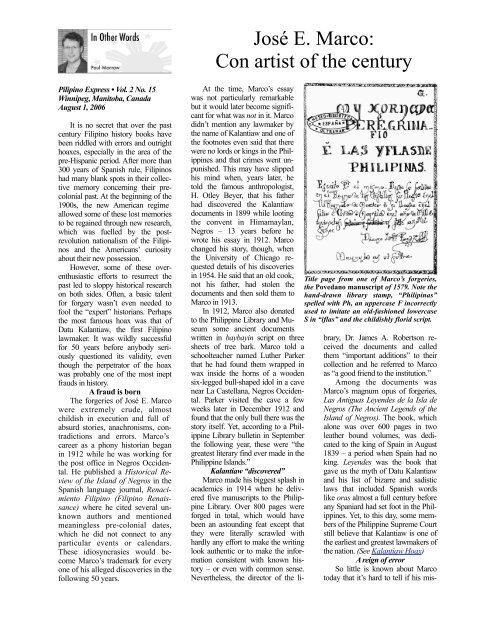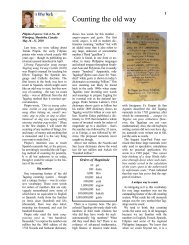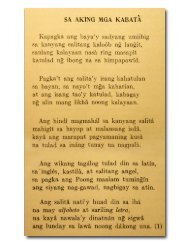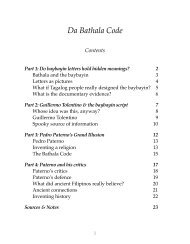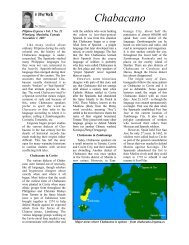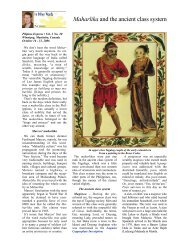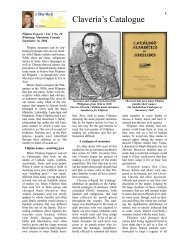060801 Con Man.pdf - Pilipino Express
060801 Con Man.pdf - Pilipino Express
060801 Con Man.pdf - Pilipino Express
Create successful ePaper yourself
Turn your PDF publications into a flip-book with our unique Google optimized e-Paper software.
José E. Marco:<br />
<strong>Con</strong> artist of the century<br />
<strong>Pilipino</strong> <strong>Express</strong> • Vol. 2 No. 15<br />
Winnipeg, <strong>Man</strong>itoba, Canada<br />
August 1, 2006<br />
It is no secret that over the past<br />
century Filipino history books have<br />
been riddled with errors and outright<br />
hoaxes, especially in the area of the<br />
pre-Hispanic period. After more than<br />
300 years of Spanish rule, Filipinos<br />
had many blank spots in their collective<br />
memory concerning their precolonial<br />
past. At the beginning of the<br />
1900s, the new American regime<br />
allowed some of these lost memories<br />
to be regained through new research,<br />
which was fuelled by the postrevolution<br />
nationalism of the Filipinos<br />
and the Americans’ curiosity<br />
about their new possession.<br />
However, some of these overenthusiastic<br />
efforts to resurrect the<br />
past led to sloppy historical research<br />
on both sides. Often, a basic talent<br />
for forgery wasn’t even needed to<br />
fool the “expert” historians. Perhaps<br />
the most famous hoax was that of<br />
Datu Kalantiaw, the first Filipino<br />
lawmaker. It was wildly successful<br />
for 50 years before anybody seriously<br />
questioned its validity, even<br />
though the perpetrator of the hoax<br />
was probably one of the most inept<br />
frauds in history.<br />
A fraud is born<br />
The forgeries of José E. Marco<br />
were extremely crude, almost<br />
childish in execution and full of<br />
absurd stories, anachronisms, contradictions<br />
and errors. Marco’s<br />
career as a phony historian began<br />
in 1912 while he was working for<br />
the post office in Negros Occidental.<br />
He published a Historical Review<br />
of the Island of Negros in the<br />
Spanish language journal, Renacimiento<br />
Filipino (Filipino Renaissance)<br />
where he cited several unknown<br />
authors and mentioned<br />
meaningless pre-colonial dates,<br />
which he did not connect to any<br />
particular events or calendars.<br />
These idiosyncrasies would become<br />
Marco’s trademark for every<br />
one of his alleged discoveries in the<br />
following 50 years.<br />
Title page from one of Marco’s forgeries,<br />
the Povedano manuscript of 1579. Note the<br />
hand-drawn library stamp, “Philipinas”<br />
spelled with Ph, an uppercase F incorrectly<br />
used to imitate an old-fashioned lowercase<br />
S in “iflas” and the childishly florid script.<br />
At the time, Marco’s essay<br />
was not particularly remarkable<br />
but it would later become significant<br />
for what was not in it. Marco<br />
didn’t mention any lawmaker by<br />
the name of Kalantiaw and one of<br />
the footnotes even said that there<br />
were no lords or kings in the Philippines<br />
and that crimes went unpunished.<br />
This may have slipped<br />
his mind when, years later, he<br />
told the famous anthropologist,<br />
H. Otley Beyer, that his father<br />
had discovered the Kalantiaw<br />
documents in 1899 while looting<br />
the convent in Himamaylan,<br />
Negros – 13 years before he<br />
wrote his essay in 1912. Marco<br />
changed his story, though, when<br />
the University of Chicago requested<br />
details of his discoveries<br />
in 1954. He said that an old cook,<br />
not his father, had stolen the<br />
documents and then sold them to<br />
Marco in 1913.<br />
In 1912, Marco also donated<br />
to the Philippine Library and Museum<br />
some ancient documents<br />
written in baybayin script on three<br />
sheets of tree bark. Marco told a<br />
schoolteacher named Luther Parker<br />
that he had found them wrapped in<br />
wax inside the horns of a wooden<br />
six-legged bull-shaped idol in a cave<br />
near La Castellana, Negros Occidental.<br />
Parker visited the cave a few<br />
weeks later in December 1912 and<br />
found that the only bull there was the<br />
story itself. Yet, according to a Philippine<br />
Library bulletin in September<br />
the following year, these were “the<br />
greatest literary find ever made in the<br />
Philippine Islands.”<br />
Kalantiaw “discovered”<br />
Marco made his biggest splash in<br />
academics in 1914 when he delivered<br />
five manuscripts to the Philippine<br />
Library. Over 800 pages were<br />
forged in total, which would have<br />
been an astounding feat except that<br />
they were literally scrawled with<br />
hardly any effort to make the writing<br />
look authentic or to make the information<br />
consistent with known history<br />
– or even with common sense.<br />
Nevertheless, the director of the library,<br />
Dr. James A. Robertson received<br />
the documents and called<br />
them “important additions” to their<br />
collection and he referred to Marco<br />
as “a good friend to the institution.”<br />
Among the documents was<br />
Marco’s magnum opus of forgeries,<br />
Las Antiguas Leyendes de la Isla de<br />
Negros (The Ancient Legends of the<br />
Island of Negros). The book, which<br />
alone was over 600 pages in two<br />
leather bound volumes, was dedicated<br />
to the king of Spain in August<br />
1839 – a period when Spain had no<br />
king. Leyendes was the book that<br />
gave us the myth of Datu Kalantiaw<br />
and his list of bizarre and sadistic<br />
laws that included Spanish words<br />
like oras almost a full century before<br />
any Spaniard had set foot in the Philippines.<br />
Yet, to this day, some members<br />
of the Philippine Supreme Court<br />
still believe that Kalantiaw is one of<br />
the earliest and greatest lawmakers of<br />
the nation. (See Kalantiaw Hoax)<br />
A reign of error<br />
So little is known about Marco<br />
today that it’s hard to tell if his mis-
Paul Morrow • In Other Words • The <strong>Pilipino</strong> <strong>Express</strong> • August 1, 2006<br />
takes were due to stupidity, laziness<br />
or just plain contempt for the experts<br />
who eagerly accepted his forgeries –<br />
or perhaps he really believed what he<br />
wrote. His blunders are too numerous<br />
to mention them all here, but<br />
some were absolute whoppers. Here<br />
are a few:<br />
• The oldest document that<br />
Marco allegedly discovered was<br />
supposedly written in the year 1137,<br />
yet it mentioned that Kalantiaw had<br />
built a fort on Negros in 1433!<br />
• A pre-colonial Visayan document,<br />
written in 1489, contained the<br />
Spanish words for “Friday” and<br />
“petty king,” and it mentioned King<br />
Charles V who was not born until<br />
1500. It is highly unlikely that anyone<br />
in the Philippines had met a<br />
Spaniard by that time, much less<br />
learned his language.<br />
• A Spanish document said to be<br />
written in 1577 mentioned trade relations<br />
with Indonesia even though that<br />
name for the archipelago was not<br />
coined until 1877.<br />
• Then, there was the 1572 map<br />
of Negros that showed the location of<br />
three churches at a time when there<br />
were no churches or even a single<br />
priest on the island.<br />
• The same map showed distances<br />
in leagues that, when measured,<br />
were equal to kilometres – even<br />
though the kilometre was not invented<br />
until 1799 (a detail found in<br />
several Marco forgeries).<br />
• Marco’s pre-colonial calendars<br />
had a seven-day week just like in<br />
Europe, though early authentic Spanish<br />
accounts reported that Filipinos<br />
had no such thing.<br />
• One comment about one of the<br />
calendars, supposedly written in<br />
1837, used the word microbe, which<br />
was not coined until 1878.<br />
• The calendars also featured precolonial<br />
baybayin writing, which,<br />
like all of Marco’s discoveries, was<br />
obviously written by someone who<br />
spoke Spanish and did not understand<br />
the baybayin script because the<br />
words followed Spanish spelling<br />
rules.<br />
The historian E.D. Hester wrote<br />
to Marco in 1954 and pressed him to<br />
explain the contradictions in one of<br />
his latest alleged discoveries. Marco<br />
wrote back and said that he was not<br />
familiar with the historical details of<br />
the book in question and, like Hester,<br />
he could not understand its author’s<br />
confusion, either. Apparently Marco<br />
tried to buy Hester’s silence on the<br />
matter by enclosing a gift of four<br />
extremely rare and valuable wartime<br />
postage stamps. This didn’t fool Hester,<br />
though, because he had worked<br />
in the very government department<br />
that had issued the special stamps<br />
and he knew at a glance that Marco’s<br />
stamps were worthless fakes.<br />
Marco’s interests were not restricted<br />
to ancient history. The historian<br />
John Schumacher exposed about<br />
40 Marco forgeries related to or attributed<br />
to Jose Burgos, one of the<br />
three priests, now national heroes,<br />
who were martyred in 1872. These<br />
included an 1873 account of the Burgos<br />
trial and the novel La Loba Negra,<br />
which Burgos himself had supposedly<br />
written in 1869. Schumacher<br />
was able to produce side-by-side<br />
comparisons of Burgos’ authentic<br />
signature and handwriting with the<br />
sloppy penmanship and poor Spanish<br />
of Jose Marco. (Hardly a single paragraph<br />
was left without a profusion of<br />
corrections when Senator Claro M.<br />
Recto edited a typewritten copy of the<br />
novel in the 1940s.) Schumacher also<br />
revealed the same kinds of absurd<br />
anachronisms that W.H. Scott had<br />
found in the pre-Hispanic fakes. He<br />
even noted that the alleged Burgos<br />
documents also had distances stated in<br />
leagues that were equal to kilometres.<br />
A life of mystery<br />
The life story of Jose E. Marco is<br />
as vexing as any of his untold number<br />
of hoaxes. He was born in the town of<br />
Marayo, Negros, which is now Pontevedra,<br />
but exactly when he was born<br />
is not so certain. Three years after his<br />
death in 1963, his widow, <strong>Con</strong>cepcion<br />
Abad Marco, said he was born on<br />
September 19, 1866, which meant he<br />
lived to the age of 97. However, his<br />
obituary in the <strong>Man</strong>ila Times in October<br />
‘63 said he was 86 years old when<br />
he died, which would have put his<br />
birth in 1877.<br />
Marco himself said he was born in<br />
1886 when he supplied biographical<br />
details to the Philippine Studies Program<br />
at the University of Chicago in<br />
1954 – but, of course, Marco was a<br />
compulsive fibber. He also told them<br />
that he had graduated from the Ateneo<br />
Municipal de <strong>Man</strong>ila in 1898 with the<br />
degree of Bachiller en Letras y Artes<br />
and then went on to take “special<br />
courses in agriculture and industrial<br />
chemistry” at the University of Santo<br />
Tomas. Neither institution has<br />
Marco’s name in their records. One<br />
would think the Ateneo, at least,<br />
would have some record of a 12-yearold<br />
boy with a bachelor’s degree!<br />
Curiously, the 1913 bulletin that announced<br />
his first contribution to the<br />
National Library said that Marco “was<br />
educated in American schools.”<br />
After his stellar education, Marco<br />
claimed he was, and perhaps he<br />
really was, a teacher from 1903 to<br />
1910, a postmaster from 1911 to<br />
1920, the secretary of a lending library<br />
in 1914, and an interpreter/<br />
clerk of court in Bacolod from 1920<br />
to 1929. At some point he was also<br />
the president of a stamp-collecting<br />
group called La Sociedad Filatélica<br />
de las Islas Filipinas.<br />
Jose Marco continued to supply<br />
scholars with hundreds of additional<br />
pages of forgeries until his death. As<br />
the years went by, though, the scholars<br />
grew suspicious and eventually they<br />
were just annoyed by his obvious lies.<br />
In 1953 he produced what he must<br />
have thought was a masterpiece, the<br />
295-page, Recopilaciones históricomédico-sociales,<br />
of 1830. He only<br />
managed to get 10 pesos for it from<br />
the National Library. The director of<br />
the library, Carlos Quirino, wrote on<br />
the title page, “I strongly doubt the<br />
authenticity of this [manuscript].”<br />
Researchers and journalists subsequently<br />
ignored the book.<br />
All the false history that Marco<br />
had spent a lifetime to fabricate was<br />
thoroughly debunked just a few years<br />
after he died but his greatest hoax,<br />
Datu Kalantiaw, still has believers<br />
today who will likely defend the<br />
authenticity of their imaginary hero<br />
until their final breath.<br />
C o n t a c t t h e a u t h o r a t<br />
feedback@pilipino-express.com or<br />
visit www.mts.net/~pmorrow.


